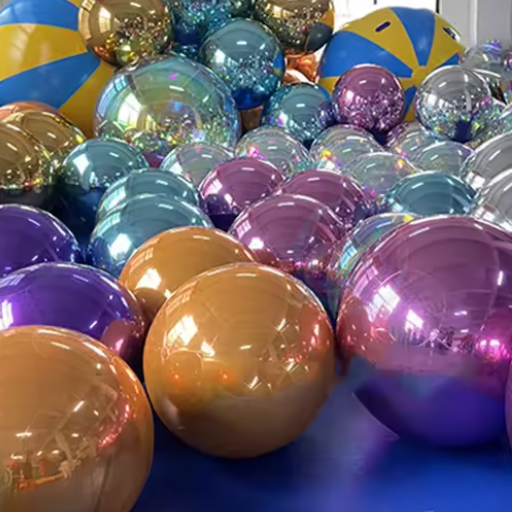Nothing else can bring a fun, festive atmosphere to a party like helium-filled balloons. These colorful and playful adornments lift any party atmosphere in both magnitude and spirit. But did you ever wonder how long a helium-filled latex balloon will float? This query becomes vital for anyone who wants to time their event perfectly and keep an Instagram-worthy setup throughout their party. This guide will delve into the various factors that affect the duration of helium-filled latex balloons‘ flight, outline tips to extend their flight time, and provide guidance on planning decorations properly. Whether you’re organizing a birthday party, a wedding, or a corporate event, this article ensures that your balloons stay inflated for as long as needed, allowing you to soak in every moment.
Understanding Helium Balloons

Helium balloons float because they are full of helium, a gas lighter than air. Helium-filled latex balloons usually float for 8-12 hours, depending on size and quality. An additional consideration would be atmospheric aspects, such as temperature or moisture content, as they can accelerate the escape of helium. To extend the float time, use a higher-grade balloon and treat it with a coating, such as Hi-Float, that helps keep helium in longer. Ensuring proper tying and inflation will guarantee the balloons will survive through the event.
What are Helium Balloons?
Latex or foil balloons filled with helium are commonly referred to as helium balloons. Because helium is a gas lighter than air, the balloons float up to become colorful decorations for special occasions and celebrations.
The Science Behind Helium
With the symbol He and atomic number 2, helium is the chemical element of Group Zero. Given its nuclear configuration, the element exhibits some unique traits — it is colorless, odorless, non-toxic, and inert.
Among the more famous properties of helium is that it is much lighter than air. Hence, there are helium balloons, anything that can go upward with a helium gas-filled balloon. When helium is in a balloon, the gas floats lighter than air, creating lift that moves the balloon upwards. Helium is safer than hydrogen and is perfect for this usage since it is non-combustible.
The majority of helium is extracted from natural gas, where it is found in trace amounts. Recent research indicates that the United States, Qatar, and Algeria possess the largest helium reserves. Global helium demand is increasing not only due to helium balloon applications but also because of its use in scientific research, medical imaging (such as MRI machines), and industries focused on aerospace.
However, helium is a scarce resource, fueling its conservation. For example, according to U.S. Geological Survey records, the total global helium reserves are estimated to be approximately 52 billion cubic meters, with over 75% located in the United States. Newer measures are being taken to increase helium recycling and forge synthetic alternatives.
Learning the science behind helium reveals its versatility and the need for careful conservation. From bright banners to paramount technology, helium remains an essential element.
How Helium Affects Float Time
The float time of a helium balloon is determined by a multitude of factors, including the type of balloon, atmospheric conditions, and the properties of helium that allow it to escape. Here are detailed descriptions of five factors affecting float time:
- Balloon Material
Some balloons, such as those made of latex, are porous, allowing helium to gradually seep through the walls and escape, thereby reducing their float time. Mylar balloons are less permeable and have a longer float duration. For example, a typical 11-inch balloon will float for anywhere from 12 to 24 hours, while a Mylar balloon will float for days on end.
- Balloon Size
Bigger balloons can hold more helium and float longer. For example, a 36-inch latex balloon can float for anywhere between 3 and 5 days if appropriately sealed, while the smaller ones will have comparatively less float time.
- Seal Quality
Any amount of leakage due to improper tying or sealing can cause the balloon to lose helium more quickly, thereby shortening the float time. For Mylar balloons, using balloon clips or heat sealers can significantly extend their lifespan.
- Environmental Temperature
Being in a warm environment means that the helium inside expands; in high-temperature conditions, this expansion could also result in the deflation or bursting of the balloons. A cooler environment helps decrease the rate of leakage, thereby increasing the float time.
- Altitude and Pressure
At higher altitudes, atmospheric pressure decreases, reducing the external pressure on the helium and causing it to expand and escape from the balloon more quickly. This shortened time of floating is in contrast to the time for floating at sea level.
Given these factors, the float time of helium balloons is sometimes adjusted for each purpose, whether it is display or celebration.
Factors Influencing Latex Balloons’ Lasting Duration

- Material Quality
The better the quality of the latex, the stronger the barrier it offers, which reduces air or helium leakage and increases the balloon’s lifespan.
- Inflation Level
The more a balloon is overinflated, the more it gets stressed, thus becoming more prone to popping or losing gas quickly. Proper inflation helps in durability.
- Temperature
Extreme heat will weaken latex and expand gases within, while cooler weather will help maintain a greater mass of gas inside the balloon.
- Environmental Conditions
Sunlight and wind can degrade latex material, reducing the lifespan of a balloon. Being indoors helps to minimize these factors.
Material Quality of Latex Balloons
The quality of latex balloons is directly determined by the type of latex used and the manufacturing practices employed. Since natural latex is derived from rubber trees and contains components that biodegrade naturally, when latex is responsibly sourced, latex balloons become environmentally friendly. High-grade latex generally exhibits greater elasticity and more resistance to degradation than lower-grade materials. The industry stated that high-quality latex balloons could stretch up to seven times their original size without bursting. In contrast, inferior-quality latex balloons could not withstand even half of such stress without tempering.
Manufacturing techniques can hinder the achievement of material quality. Vulcanization is a process that treats the latex with sulfur, enhancing its durability, elasticity, and resistance to environmental factors such as heat and sunlight. It is said that advanced-method-made balloons last 20-30% longer than the traditional-method-made ones under similar conditions.
Additionally, additives such as antioxidants and plasticizers enhance and prolong the performance and lifespan of latex balloons. Antioxidants slow down the natural degradation that occurs through exposure to air and sunlight. At the same time, plasticizers keep balloons flexible across a range of temperatures, making them less prone to cracking or tearing.
High-quality latex balloons can stay intact for months when stored in a cool, dry place. Poorer-quality balloons begin to oxidize, exhibiting evident surface dullness or stickiness, even after limited exposure to air or light. Hence, when life expectancy and performance are important, it is essential to stick to reputable brands.
Environmental Conditions
Latex balloons are sensitive to environmental factors. Sunscreens are advised to be kept in a cool, dry place, which also applies to latex balloons. Keeping the area free from sunlight and humidity will help them maintain high quality for a prolonged period. Premature oxidation can work against the sheen of the balloons or cause stickiness and awkwardness. Proper storage and selection of the best article make sure that the balloons retain their glory for all your needs.
Balloon Size and Shape
Choosing balloons, based on size and shape, obviously matters depending on your needs. Balloon sizes and shapes vary in terms of their decoration capability or professional use. Some of the popular balloon sizes and shapes are as follows:
- Standard Round Balloons – This type is the most common and typically measures between 5 inches and 12 inches in diameter. They are multipurpose and can be used on almost any occasion.
- Large Round Balloons- Often used for heavy decorations, the big-balloon theme gives a considerable threat, and they can be anywhere from 16 inches to 36 inches in diameter.
- Heart-Shaped Balloons – A little bit of romance here and there is a good addition; thus, these balloons are suited for weddings, anniversaries, and Valentine’s Day, available in various sizes.
- Long/Tubular Shape Balloons – Thin and long, these balloons are ideal for balloon art and creation. They are approximately 2 inches wide and range in length from 60 inches to over 60 inches.
- Star-Shaped Balloons – Perfect for theme events, birthdays, or special occasions, these star-shaped balloons are showstoppers, typically ranging in size from 18 inches to 24 inches.
The correct size and shape of balloons will have a sufficient impact on the visual appeal of your event and its practicality.
Average Float Time for Helium Balloons

The average float time for helium balloons largely depends on their material and size:
- Latex Balloon (11 inches): Floats for around 12-24 hours.
- Foil/Mylar Balloon (18 inches): Floats for around 3-5 days, sometimes longer.
Treatments such as Hi-Float significantly enhance the float time of latex balloons. Always keep in mind other parameters that alter the length of time that a balloon can stay afloat, such as temperature and pressure.
How Long Do Helium Balloons Last?
The lifespan of helium balloons typically spans 12 hours to even a decade, with a wide range of information available concerning the materials, sizes, and environmental factors.
Comparing Latex Balloons and Foil Balloons
|
Key Point |
Latex Balloons |
Foil Balloons |
|---|---|---|
|
Material |
Natural rubber latex |
Mylar (nylon with aluminum coating) |
|
Cost |
Affordable ($0.10–$0.50 each) |
Expensive ($2–$5 each) |
|
Durability |
Short lifespan (12–24 hours with helium) |
Long-lasting (up to 2 weeks with helium) |
|
Customization |
Limited designs, vibrant colors |
Custom shapes, metallic finish |
|
Eco-Friendliness |
Biodegradable (4 months–8 years) |
Non-biodegradable |
|
Helium Retention |
Short (hours) |
Long (days to weeks) |
|
Best Use |
Budget-friendly, casual events |
Formal, themed, or long events |
|
Reusability |
Single-use |
Reusable with self-sealing valve |
|
Popping Risk |
High (fragile material) |
Low (durable material) |
|
Environmental Impact |
Low (if disposed of properly) |
High (difficult to recycle) |
What Affects Their Float Time?
Several aspects influence the float time of helium balloons. Here are five important ones that affect float times:
- Material of the Balloon
Latex balloons have shorter float times than their foil counterparts because of their porous nature. Latex allows helium to escape more quickly, whereas foil balloons are more resilient and hence retain helium for longer. For example, an untreated latex balloon may remain afloat for 12-24 hours, though a foil balloon will stay afloat for 5 days or more.
- Size of the Balloon
Bigger balloons generally float for longer, as they hold more helium within. For a float time of 8-12 hours, a 9-inch latex balloon can barely make it. In contrast, an 18-inch bigger foil balloon will float for days.
- Environmental Conditions
The temperature and pressure of the surroundings greatly deform the float time. High temperatures usually mean high expansion of helium, which can potentially burst balloons; low temperatures, on the contrary, cause contraction of helium, which reduces float time. Punctures can also occur if a balloon is suddenly struck by wind or a sharp object.
- Seal Quality
The sealing method influences the balloon’s helium retention time. A balloon tied loosely or with an inadequate seal will lose helium faster. Using clips for foil balloons or heat sealers can improve helium retention and prolong the float time.
- Additives and Treatments
Substances like Hi-Float greatly extend the float time for latex balloons. Hi-Float coats the inside of the balloon, thereby decreasing helium diffusion. For instance, the addition of Hi-Float to a latex balloon can extend the float time from 12 hours to almost 2-3 days.
Extending the Float Time of Helium Balloons

Some of the primary considerations to maximize the float time of helium balloons are:
- Choose Good-Quality Balloons. High-quality latex or foil balloons should be used because they are less prone to leakage and better at holding helium.
- Apply Hi-Float to Latex Balloons. A latex balloon can be coated with Hi-Float before inflation. It shields the inner surface, greatly retarding helium loss.
- Inflate Properly. Balloons should be fully inflated but never overinflated, as this will weaken the material and increase balloon deflation.
- Seal the Balloon Properly. Use clips or heat-sealers with foil balloons. For latex balloons, tie them tightly so that they cannot lose too much helium.
- Store Properly. Store balloons in a cool, dry environment away from heat or sharp objects that might damage the material, thereby reducing their float time. Also, avoid exposing balloons to direct sunlight.
These tips will make helium balloons float longer and stay brighter for your event!
Techniques to Keep Balloons Inflated Longer
- Use High-Quality Balloons
It is best to use premium latex or foil balloons because they are manufactured to hold helium for extended periods. By definition, a good-quality balloon has fewer leaks and can float for approximately 12-24 hours when inflated with air; for foil balloons, the float time can last several days.
- Applying Hi-Float Solution
Hi-Float is a product for latex balloons that, when placed inside, forms a thin coating and slows the escape of helium. If used correctly, this can help latex balloons float in the air for about a week.
- Inflate Balloons Properly
Overinflation or underinflation will weaken the balloon. The ideal size is the one indicated by the balloon manufacturer. Inflate the balloon to the correct size to achieve the best results and durability.
- Avoid Extreme Temperatures
Helium expands when it is warm and contracts when the temperature decreases. Thus, balloons kept at rising temperatures pop, while those kept inside an air-conditioned room tend to shrink, losing helium. Straight balloons need to be stored in moderate temperatures to retain their shape.
- Use Balloon Weights and Anchors
Weigh down helium balloons to prevent excessive movement down, up, and sideways, which can result in tangling or accidental ruptures. Anchored balloons stay put and are less likely to collide with sharp objects or heated surfaces.
Using Balloon Treatments and Coatings
Balloon coatings should indeed be applied for the very life and looks of the balloons. Hi-Float-type products coat the inside of latex balloons, creating a barrier that slows down the escape of helium or air. According to manufacturers, such latex balloons could float 2 to 3 times longer than untreated ones, with some even holding on for a whole week indoors in ideal conditions.
Such treatments seal those infinitesimal openings in the latex that gases naturally permeate through, thereby aiding any event that requires balloons to stay inflated for a lengthy time like weddings or two-day celebrations. Another advantage coating provides is the shinier and more vibrant look of the balloons.
For Mylar balloons, the coatings offer protection against surface damage, such as scratches and ink smears, rather than promoting the retention of helium. To optimally maximize the effectiveness of treatments, apply just before inflation and ensure even distribution. Their effectiveness may differ from place to place, depending mainly on humidity and temperature, but they certainly offer a cheap solution for making decorations last longer and look better.
Choosing the Right Decorations for Longevity
|
Key Point |
Recommendation |
|---|---|
|
Material Quality |
Invest in durable materials like wood, metal |
|
Sunlight Exposure |
Avoid direct sunlight to prevent fading |
|
Humidity Control |
Maintain moderate humidity for wood, fabrics |
|
Cleaning Routine |
Dust and clean regularly with soft cloths |
|
Protective Coatings |
Use sealants for wood and metal items |
|
Storage |
Store seasonal items in cool, dry places |
|
Weather Resistance |
Choose UV-resistant and treated materials |
|
Rotation |
Rotate decor to prevent uneven wear |
|
Fragrance Care |
Trim candle wicks, flip diffuser reeds |
|
Polishing |
Polish metals and wood occasionally |
Common Myths About Helium Balloons

| Myth | Fact |
|---|---|
|
Helium is flammable |
Helium is inert and non-flammable. |
|
Helium balloons always float |
Floatation depends on balloon material, inflation, and conditions. |
|
Helium is scarce |
Helium is produced naturally but must be used responsibly. |
|
Helium balloons are dangerous |
Helium is safe; inhalation and misuse should be avoided. |
|
Balloons harm the environment |
Latex balloons are biodegradable; proper disposal is essential. |
|
Helium balloons are expensive |
Costs vary; helium is a fraction of total balloon expenses. |
|
Balloons are only for parties. |
Helium balloons are utilized in science, advertising, and promotional activities. |
Do Helium Balloons Stay Inflated Forever?
Helium balloons never stay inflated forever due to the characteristics of the helium molecule, which is very tiny and lightweight, gradually leaking away through the minute pores in latex or foil balloons. Latex balloons deflate faster and are thus considered inferior because latex is porous, allowing helium to escape quickly. A typical latex balloon with helium begins to lose buoyancy after 12-24 hours of inflation.
Foil balloons, on the other hand, are less porous and can therefore hold the helium for much longer. These balloons can remain inflated for a couple of days to weeks, depending on factors such as temperature and exposure to sharp objects. Even foil balloons will lose helium over time, due to the gradual escape of gas molecules.
To increase the longevity of helium balloons, specific methods can be applied. Applying the protective gel Hi-Float inside the latex balloon before inflating it significantly slows down the escape of helium, thereby allowing the balloon to float for days. It is also advisable to avoid exposing balloons to extreme temperatures: heat accelerates helium leakage, whilst cold causes gas condensation, diminishing buoyancy in the short term.
A helium balloon makes a lovely setting for a celebration, and we should remember that helium is a finite resource, with significant scientific and industrial uses. With this in mind, responsible use of helium, along with considering alternatives such as air-filled decorations, helps conserve this precious resource.
Can You Reinflate Helium Balloons?
Strictly speaking, helixing of balloons can be carried out depending on the type of balloon and its condition. Foil balloons, also known as Mylar balloons, when offered with a self-sealing valve and in good condition, can be topped up with helium. In the context of latex balloons, they hardly ever stand any sort of reuse as they lose their elasticity and can no longer hold helium.
Understanding Confetti Balloons and Their Longevity
Confetti balloons add fun, flavor, and beauty to any party, but their duration depends on a few factors. Here are five attributes that help you understand their durability and how to maximize it:
- Type of Material
Generally, confetti balloons are made either from latex or foil. A latex confetti balloon will degrade faster due to the natural sporadic nature of the latex, whereas foil balloons are sturdier and will retain their helium for much longer.
- Inflation Method
Confetti balloons that are filled with helium float around, but their lifespan may also be shortened compared to those filled with air. Air-filled confetti balloons usually last days or even weeks indoors.
- Environmental Conditions
Exposure to heat, direct sunlight, or high humidity will decrease the lifespan of confetti balloons. Latex balloons, in particular, tend to pop or deflate when exposed to extreme heat.
- Proper Sealing
The sealing mechanism is crucial for longevity. Self-sealing foil balloons typically retain their helium longer than manually tied latex balloons, as the latter slowly leak helium over time.
- Confetti Placement
For the most significant visual effect, rub the outside of the balloon with a cloth, preferably wool, to generate static electricity. This will help keep the confetti attached to the inside of the balloon. Still, the more that static electricity works, the faster the balloon material may degrade.
With the above things in mind, you can plan your decorations better, keeping the confetti balloons for your party as long as possible.
References
-
Harvard ADS – Constructing Solar and Zero Pressure High Altitude Balloons
This academic abstract provides insights into balloon dynamics, including helium retention and float times. -
National Weather Service – Education Corner Weather Balloon
This government site explains the behavior and lifespan of weather balloons, which are often made of latex.
Frequently Asked Questions (FAQ)
How Long Do Helium Balloons Last?
Helium balloons typically last between 8 and 12 hours when filled with helium. Factors such as the size of the balloon, temperature, and the material of the balloon can influence how long they stay inflated. For instance, larger balloons tend to hold more helium and may last longer than smaller ones.
What Can I Do to Make My Balloons Last Longer?
To extend the float time of latex balloons, consider using a product called Hi-Float. This liquid helps seal the inside of the balloon, slowing down the escape of helium and allowing your balloons to stay inflated for a longer period.
How Long Will My Balloon Stay Afloat Outdoors?
Balloons filled with helium can last longer indoors compared to outdoors. Cold temperatures and wind can cause helium to escape more quickly, resulting in faster deflation. It’s best to keep your balloons indoors as much as possible to maximize their float time.
Do Mylar Balloons Last Longer Than Latex Balloons?
Yes, Mylar balloons, also known as foil balloons, generally last longer than latex balloons. They are made from a non-porous material that prevents helium from escaping as quickly, allowing them to float for several days or even weeks.
How Can I Keep My Balloons Filled With Helium Longer?
To keep your balloons filled with helium longer, avoid exposing them to direct sunlight or extreme temperatures. Additionally, using Hi-Float can help, as it creates a barrier inside the balloon that reduces helium leaks.
What Causes Balloons to Deflate Quickly?
Several factors can cause balloons to lose helium quickly. The material of the balloon plays a significant role, as latex balloons are porous and allow helium molecules to escape more readily. Additionally, punctures or tears in the balloon can cause it to deflate more quickly.
How Long Do Latex Balloons Last When Inflated?
Latex balloons typically last about 5 to 7 hours when filled with helium. However, this can vary based on the size of the balloon and environmental conditions. Larger latex balloons can last longer due to their greater volume, which allows them to hold more helium.
What is the Float Time of Helium-Filled Balloons?
The float time of helium-filled balloons varies; latex balloons generally float for about 8 to 12 hours, while Mylar balloons can float for days. To achieve the maximum float time, consider factors like balloon size and the environment in which they are placed.
How Do Cold Temperatures Affect Helium Balloons?
Cold temperatures can significantly impact the performance of helium balloons. When exposed to chilly, helium gas contracts, causing the balloon to appear deflated. Keeping balloons in a moderate temperature environment will help them stay inflated for a longer time.









